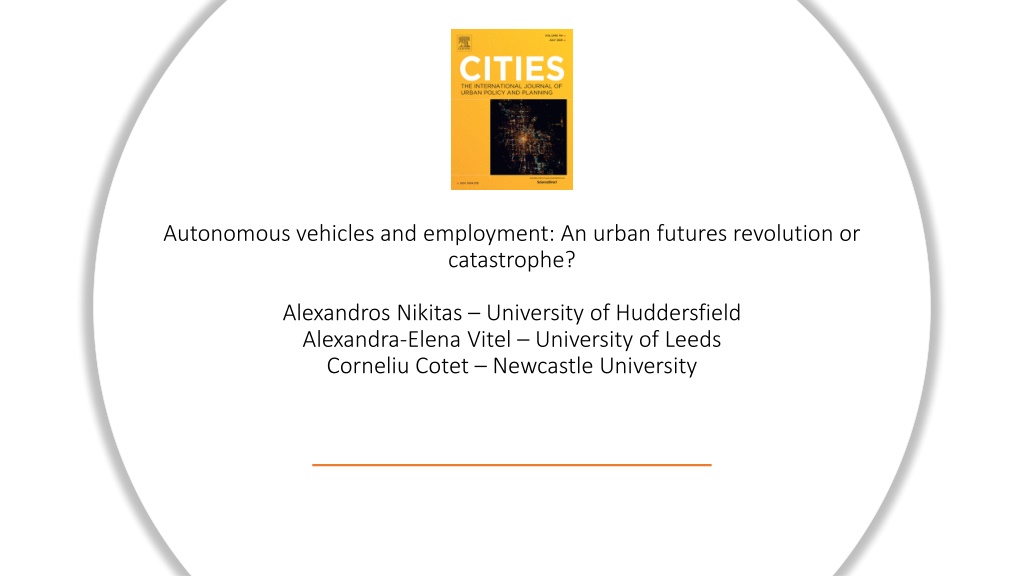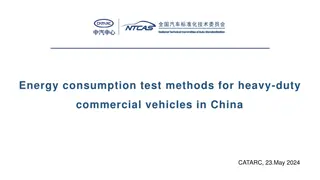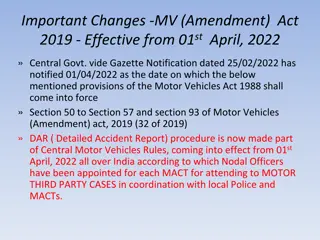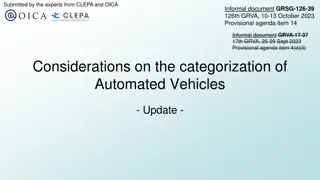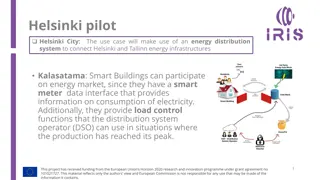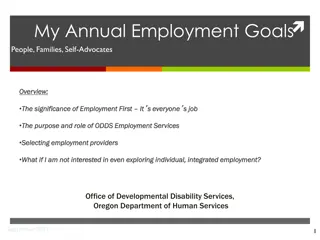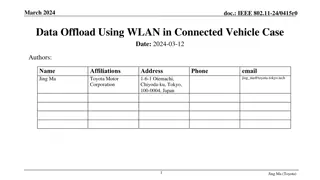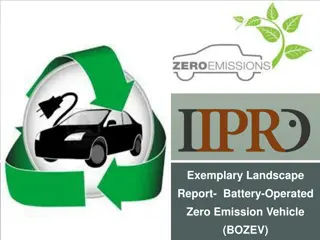The Impact of Autonomous Vehicles on Employment
The study explores public perceptions regarding the employment effects of autonomous vehicles (AVs) in the transport and logistics industry. It delves into potential disruptions, new employment opportunities, and policy recommendations post full-scale AV integration.
Download Presentation

Please find below an Image/Link to download the presentation.
The content on the website is provided AS IS for your information and personal use only. It may not be sold, licensed, or shared on other websites without obtaining consent from the author.If you encounter any issues during the download, it is possible that the publisher has removed the file from their server.
You are allowed to download the files provided on this website for personal or commercial use, subject to the condition that they are used lawfully. All files are the property of their respective owners.
The content on the website is provided AS IS for your information and personal use only. It may not be sold, licensed, or shared on other websites without obtaining consent from the author.
E N D
Presentation Transcript
Graphical user interface, website Description automatically generated Autonomous vehicles and employment: An urban futures revolution or catastrophe? Alexandros Nikitas University of Huddersfield Alexandra-Elena Vitel University of Leeds Corneliu Cotet Newcastle University
Highlights AVs despite a wealth of potential benefits could generate labour market disruption and new layers of employment- and employability-related social exclusion. The paper presents an online survey of 773 responses from 50 different countries examining perceptions about AV-related employment repercussions. Age, field of work/study, self-perceived level of AV awareness, income and gender influence respondents perceptions of the post-AV transport labour market. Low-skilled staff, non-transport professionals, younger individuals and people uninformed about AVs feel, more than other respondents, that AVs might cause massive redundancies in the industry. Reskilling and trust-building activities should be adopted by industry and policy stakeholders taking forward this transition.
Research aims This study aims to examine the public perceptions of the effects that the introduction of AVs will generate to employment in the transport and logistics industry. More specifically, the paper intends to: (i) identify people's perceptions of the after-effects of a full-scale AV launch on employment, (ii) identify new opportunities and challenges that will arise and skills that will be sought after once AVs will be fully launched, (iii) provide policy recommendations about how to ease labour market disruption for the societies, in general, and those employed by the transport sector, in particular, after the transition to an automated transport paradigm.
The arrival of AVs and the future employment landscape The self-driving vehicle concept per se stimulates human cognisance to suppose that it will convey a full replacement of industrial employment, rather than simply supply assistance (Ransbotham, 2017) . The dystopian forecast pictures historic employment disruption after the establishment of AVs as the norm, with mass job losses, cheap labour, and increased control (Halteh et al., 2018; Litman, 2017) . As businesses pursue constant advances in transport efficiency, the commercial vehicle sector including taxis, ride-sourcing and trucking are expected to be amid the first adopters of self-driving technology (Wadud, 2017) . Massive employment disruption is also foreseen in vehicle manufacturing, rental, finance, retail and petrol stations, as well as road transport support industries (Davidson & Spinoulas, 2015) especially if SAVs prevail meaning that car fleets will be significantly reduced (Narayanan et al., 2020) providing lower fares to service users (Martinez et al., 2015) .
The arrival of AVs and the future employment landscape AVs are projected to reduce expenses on compulsory vehicle-related insurance policies (Fagnant & Kockelman, 2015), overhaul facilities (Tomita, 2017), road traffic police forces, parking inspection provision, legal service providers (Davidson & Spinoulas, 2015), auto-repair industries and medical and emergency services (Clements & Kockelman, 2017) . The increased road efficiency of AVs, in the long-term, might reduce the need for future transport infrastructure, thus reducing jobs in road construction, engineering and perhaps transport planning and modelling (Davidson & Spinoulas, 2015). Typically, employees who have not enhanced their skillsets might find themselves in extremely low-paid positions. But it is likely that affected personnel will expect their occupations to be substituted with jobs that can pay comparable wages (Snyder, 2016) .
Research methodology A quantitative online survey was employed for capturing people's perceptions of how the introduction of AVs will affect employment. The survey included 33 questions and the average time required to complete it was 10 min. The questions were organised in six thematic sections namely: the respondents' awareness about the effects of automation on industry; legal concerns; general trust; employment concerns; economic paybacks and industry-specific aftershocks; and demographic characteristics. Descriptive analysis and ordinal regression modelling have helped to interpret the data. The underpinning hypothesis that is tested by the survey suggests that people's perceptions of job losses in the transport sector relate to their understanding of AVs, their concerns about their own employment, and their individual background characteristics.
Conclusions On average, the respondents argued that the transport industry will be the first to experience job losses because of AVs and that governments are not currently equipped for the transition that the introduction of driverless technology would naturally entail to workplaces. The potential introduction of AVs is feared more by low-income, less educated and uninformed people. The younger generation, although is typically more open to technological changes is also more prone to associate AVs with adverse employment disruption. People from other sectors than transport are more inclined to associate AVs with job losses in the transport industry and beyond; transport professionals, are less likely to feel that their own posts and transport professionals ' jobs in general will be at risk. The majority of our respondents however were ready to accept that the entrance of driverless technology on the mobility service provision would have an enormous impact on transport industry's job market.
Conclusions An AV-centric technological revolution would lead to an employment revolution, with both its positive and negative consequences. a multitude of opportunities for increased productivity, efficiency, flexible working, higher salaries and cost reductions may appear many occupations will disappear marginalising the role(s) of low-skilled personnel Employees of the future transport arena and beyond will be in a better position (and more employable) if they are more IT-literate, better informed and knowledgeable about AVs (and AI in general) and develop higher communication and interpersonal skills that will allow them to work in posts that will be linked with innovation, critical thinking, creativity and non-repetition. Standarised and repetitive low-skill transport employment will not translate well in the era of automated mobility.
